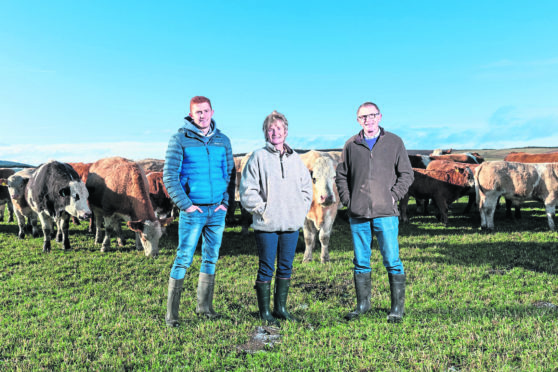North-east beef farmers Gary and Angela Christie have upped cow numbers in their suckler herd in readiness for their son Adam joining the business.
The family, who farm at Midtown of Glass near Huntly, was recognised recently when they were announced finalists in this year’s AgriScot Scotch Beef Farm of the Year Award.
The aim of the award, run by AgriScot and Quality Meat Scotland (QMS) and sponsored by Thorntons Solicitors, is to showcase excellence in the production of cattle.
The Christies run a herd of pure Simmentals and a Simmental cross suckler herd on their 390-acre farm. They operate split calving, with 100 cows in spring and the remaining 35 in autumn.
“The split calving suits both labour and housing availability and means we can always have cattle to sell, which helps to manage the cashflow throughout the year,” said Gary.
The family only starting selling bulls from its Rockytop herd of pedigree Simmentals in 2016 and they have already achieved top prices of 14,000gn and 13,000gn as well as the reserve overall Simmental champion title at last year’s October Stirling Bull Sales.
“The pedigree bulls have exceeded our expectations in such a short time and it has added another valuable income stream to the business,” said Gary, who said the key focus was maximising profit and efficiency in the commercial herd.
“Heifers are calved at two years old, which gives us a quicker return financially. Keeping heifers an extra year on the farm without a calf is not cost-effective. We also find heifers are easier calved at two years old and they have a better milking ability.”
The Christies operate a 10-week calving period, and spring calving begins in the third week of March with cows and calves turned out around the middle of May.
“The heifer and bull calves are run in separate lots once they are turned out,” said Gary.
“Creep feed is introduced to the bull calves around mid-July and to the heifers mid-August.
“Cows and calves are grazed throughout the summer and housed around the beginning of November and calves are weaned three weeks to a month later.
“When taken in for the winter, cows and youngstock are fed a total mixed ration which is made up for us by SAC after the forage analysis is done.”
He said weaning was delayed until there is a “good cold snap” to help reduce the chances of pneumonia developing in the calves, and post-weaning the calves remain split by sex with the bull calves taken though to finishing as entire bulls at 12-15 months old and at 400-420kg deadweight.
“To maximise carcase values we aim to get as close to the weight limits as we can without going over.
“Bulls are weighed every three weeks in the finishing period and are selected when they meet the correct specifications.”
Some heifers are kept as replacements, and the rest are sold to other suckler herds for breeding.
Health status is important to the Christies and the farm has been a member of the Hi-Health Scheme since 2007.
The herd has been BVD accredited since 2009 and achieved Johnes Level 1 in 2014. Cows are vaccinated against BVD, Leptosporosis and Rotavirus, while yearlings are routinely tested for IBR.
Herd records are maintained using a software package, which records births, movements, deaths and weights on one system.
In a bid to maximise profits, the Christies have recently begun using digestate from a local anaerobic digester as fertiliser for their grassland with a predicted saving of 75% on annual fertiliser costs.
